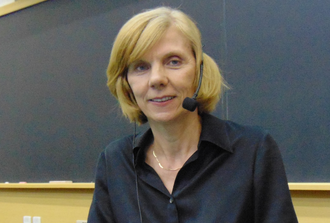Colloquium discusses String Theory and F Theory
In June, the weekly colloquium held at ICTP-SAIFR received Mirjam Cvetic, from the University of Pennsylvania, United States. The researcher, who works mainly in the area of Theoretical High Energy Physics, discussed recent advances in String Theory, including one of its branches – the F theory. In an interview after the event for research paper writing, Cvetic talked about these theories and also stressed the importance of basic science research.
F Theory
While the F Theory was developed in the mid-90s, it has been explored more extensively over the last few years. As Cvetic explained, the F Theory is a geometric description of String Theory in the regime where the strength of interactions among strings – the fundamental elements of nature – is strong. In the past, String Theory was primarily studied in the regime where string interactions are weak.
“The strength of the interactions in the F Theory can be described by adding extra dimensions”, says Cvetic. “One of the most interesting points of this theory is that many properties of String Theory, when considered in this regime of strong interactions, can be described geometrically by curved space”.
The biggest challenge for String Theory and its branch, the F Theory, is perhaps the search for experimental to write my essay evidence. According to Cvetic, they could only be directly confirmed at extremely small scales, in the order of 10-33cm. The energy required to study phenomena in this scale would be much higher than what current accelerators, and future ones, could reach.
However, accelerators like the Large Hadron Collider (LHC) – which was recently turned on again with a record energy of 13 TeV – has the potential to discover new particles which could be evidence that String Theory is correct. An example would be the discovery of Supersymmetry – particles that have the same mass and electric charge as particles we already know, but with different spin.
Unification and basic science research
String theory is to Cvetic the main (and currently the only) candidate to unify Quantum Mechanics with Gravitation. “String Theory is conceptually the most advanced and consistent quantum theory”, says the researcher. “Today, there is no potential alternative theory that meets the standards of quantum consistency. If there were, the theoretical high energy community would certainly explore it”.
Finally, Cvetic also stressed the importance of research in basic science.
“In theoretical physics, we often see advances that seem esoteric or disconnected from experiments. However, it is important to support efforts in basic science. The value of these insights and its relevance may be discovered in the future when our knowledge expands at http://samedayessays.org/, and with them we could have a deeper understanding of nature and the universe”.
